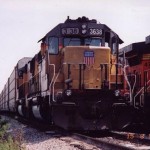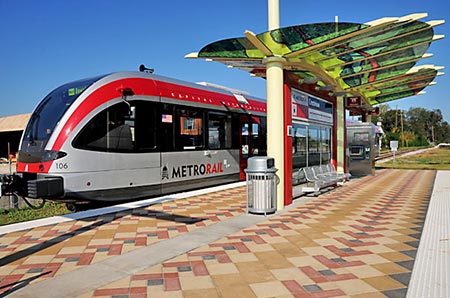Commuting Passenger rail: Austin
by Patrick
Comments Off on Austin back in the passenger rail game
Austin back in the passenger rail game
After a 70-year hiatus, much debate and then a yearlong delay, Austin will soon join American cities that have added passenger rail back into the commuting mix.
On March 22, Capital Metro will start running diesel trains on a 32-mile route with nine stops from Leander to downtown Austin, the agency recently announced. A one-way trip will last a little more than an hour and the regular fare will be $3.
Trains will come by every 35 minutes during peak travel times, the Austin American-Statesman reported. Nearly 200 people can fit in a car, including standing room.
To match the capacity of a highway lane, you’d have to hook up three cars at a time and run them every 15 minutes.
Metro shelled out $105 million for its rail system, a figure that doesn’t include some direct costs, the Statesman said. Still, at about $3.3 million a mile, using an old rail line, the city struck a bargain as far as rail projects go.
Commuting Passenger rail Roads Toll roads Transit: Broadway South Alamo Street streetcars U.S. 281
by Patrick
Comments Off on Streetcar dreams: Now it’s time to talk money
Streetcar dreams: Now it’s time to talk money
After starting the fiscal year by shaving $19 million in spending, including 330 jobs, the city is now being asked to kick in $17 million to build a two-mile streetcar line.
That’s just part of the bill to buy streetcars and lay rails along Broadway and South Alamo Street by 2014. The county, VIA Metropolitan Transit and the federal government could also pony up to help pay what would be an estimated $90 million.
City Council heard the pitch this afternoon.
“If there was any sticker shock … council members mostly kept it to themselves,” the Express-News wrote.
The city hasn’t made any commitments, at least not yet.
At $45 million a mile, the price tag is quite a bit cheaper than, say, turning U.S. 281 out by Stone Oak into a superhighway, or, I should say, tollway.
Ah, but already I’m talking apples and oranges. This quaint two-mile rail line wouldn’t be a wide commuter route helping connect San Antonio’s core to its fringes.
Nope, unlike U.S. 281’s role as an artery for sprawl, the rail line, if done well, would be a magnet for compact living, working and playing. The idea is to drive some growth to the inner city, by creating a place where people would gladly leave their cars behind more often. Tourists would love it too.
Nonetheless, critics and proponents will duke it out with such comparisons. And with so many angles on varying public and private costs, some visible and some not so visible, expect a debate that’s about as clear as mud.
Docs and links:
Automobiles Bicycles History Passenger rail Railroads Roads
by Hugh
Comments Off on San Antonio transportation history talks
San Antonio transportation history talks
Beginning Saturday February 20 at 9:30 AM, I will be be giving a series of four talks on local transportation history at the main public library downtown. Technology willing, they will be accompanied with PowerPoint slide shows. Admission is free. I will have copies of my two local transportation history books available for sale.
Here is the topic schedule:
Saturday February 20, 9:30 – 11;30 AM – Ox, mule and horse drawn transportation.
Saturday February 20, 1:30 – 3:30 PM – Railroads; 1850 to the present
Saturday February 27, 9:30 – 11:30 AM – Public transportation, streetcars, jitneys and buses
Saturday February 27, 1:30 – 3:30 PM – Private transportation, from the bicycle to the present.
History Laws and policies Passenger rail Railroads Safety Uncategorized: steam power
by Hugh
Comments Off on Live steam coming to San Antonio
Live steam coming to San Antonio

1925 Baldwin steam locomotive at Pearl Brewery
Question: How do you return a long dormant steam locomotive back to active passenger service in 2010, with all the heightened concerns about safety? Answer: Very, very carefully. This ain’t 1964. Way back then early Texas Transportation Museum members including one Dave Wallace, acquired the 1925 Baldwin 0-4-0 steam locomotive from New Braunfels where it had sat idled in a shed since being retired around 1928, brought it to San Antonio, placed it on tracks adjacent to Pearl Brewery, simply filled the boiler with water and fired it up. While it didn’t explode, it sent out enough smuts and soot that those same volunteers ended up cleaning car windshields for several blocks around. more »
Commuting Passenger rail: commuter rail light-rail
by Brian
Comments Off on The difference between commuter rail and light-rail
The difference between commuter rail and light-rail
History Passenger rail Railroads Uncategorized
by Hugh
Comments Off on Transportation Museum Christmas Show
Transportation Museum Christmas Show
 It’s been a while since I posted here but I’ve been busy setting up “Santa’s railroad Wonderland” at the Texas Transportation Museum. In its eleventh year, this eight night event has become a significant source of revenue for this small, independent museum, which receives no government funding of any kind, from city, county, state and federal levels. So we get by, solely, on visitor support. We must be doing something right because we are still here after 45 years.
It’s been a while since I posted here but I’ve been busy setting up “Santa’s railroad Wonderland” at the Texas Transportation Museum. In its eleventh year, this eight night event has become a significant source of revenue for this small, independent museum, which receives no government funding of any kind, from city, county, state and federal levels. So we get by, solely, on visitor support. We must be doing something right because we are still here after 45 years.
Click http://www.txtransportationmuseum.org/SHD.htm for more information about “Santa’s Railroad Wonderland.”
Commuting History Oil and gas prices Passenger rail Railroads Roads Transit Travel
by Hugh
Comments Off on SA – Austin passenger rail still dead
SA – Austin passenger rail still dead
Like the old Saturday Night sketch about Generalissimo Franco, passenger rail between San Antonio and Austin is still dead. Oh a mortician applied a new coat of make-up, but the poor old stiff ain’t going nowhere. After twelve years of failure, a new name and an application for $5 million of tax payer money was enough to create a blip of interest but even that has not lasted long. Oh well.
Hey, what happened to all the talk about commuter rail?
Anybody remember the Austin-San Antonio Intermunicipal Rail District? No? Yes? If so, forget about it.
I mean, forget about the name, which was sort of long and obtuse anyway. The six-year-old district, authorized by a 12-year-old state law, has shed the name and dumped its old web site in exchange for a punchy, fresh re-branding.
On Monday, regional leaders will announce the name change to Lone Star Rail District as well as the reborn web presence at LoneStarRail.com. You don’t have to wait to see the site — it’s already live.
Commuting History Passenger rail Railroads Safety Transit Travel
by Hugh
Comments Off on No news = good news for railroads
No news = good news for railroads
 I’m guessing you haven’t heard much about the railroads recently. The more they fly under the radar the better they like it because these days, when it comes to railroads, only bad news is good news. The Union Pacific is probably happy. Sure beats 2004 and the torrent of bad news way back then. These days they are regarded as just one step up from the water and sewage systems. These only make the headlines when something goes wrong. Certainly there are still far too many accidents at grade level road crossings but few blame the railroad for this anymore. If drivers are willing to risk absolutely everything to beat the train, just to save a minute or two and not miss the beginning of “Jeopardy” or something equally banal, well, you cannot legislate away stupidity.
I’m guessing you haven’t heard much about the railroads recently. The more they fly under the radar the better they like it because these days, when it comes to railroads, only bad news is good news. The Union Pacific is probably happy. Sure beats 2004 and the torrent of bad news way back then. These days they are regarded as just one step up from the water and sewage systems. These only make the headlines when something goes wrong. Certainly there are still far too many accidents at grade level road crossings but few blame the railroad for this anymore. If drivers are willing to risk absolutely everything to beat the train, just to save a minute or two and not miss the beginning of “Jeopardy” or something equally banal, well, you cannot legislate away stupidity.


